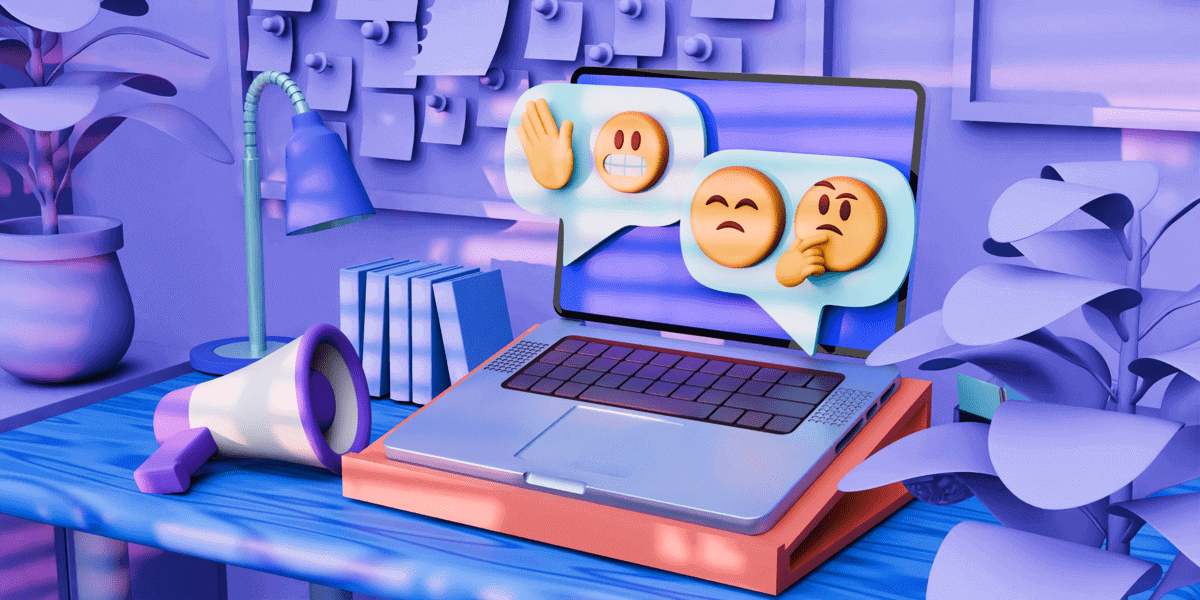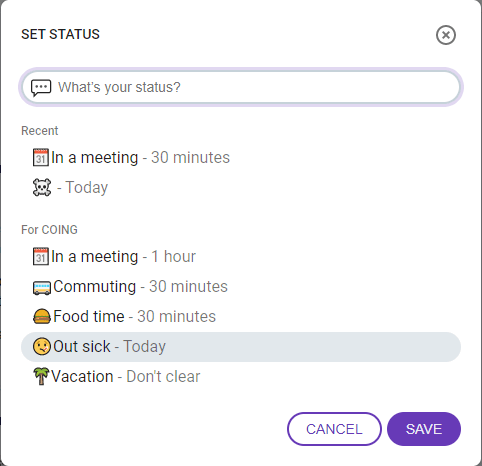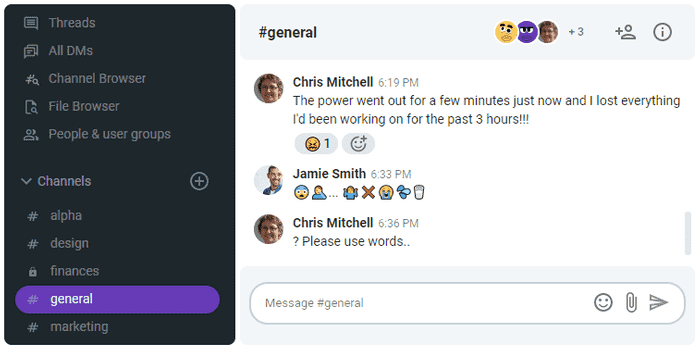Emojis have managed to infiltrate nearly every facet of our online interactions. And it’s no wonder — written virtual communication is in desperate need of emotional subtext. Hence, emojis are used as visual representations of our emotions. They enrich plain text with nuances in meaning and tone that help us identify the true intent behind messages. Plus, they can be a lot of fun 😃. Moreover, these small digital images that express ideas and emotions are used in business as well.
But, not all types of communication are equally receptive to fun. In particular, the use of emojis in business communication has always been a point of discussion. Even now, when 80.69% of the world’s population walks around with at least one smartphone in their pocket, sending your boss an email with a smiley-face attached might get you in a world of trouble… or you might get a smiley in return. It could honestly go either way.
So, if you were wondering whether it’s OK to use emojis in the workplace, the short answer is — it depends.
The long answer is really long (4,264 words, to be exact).
In the 4,264 words that follow, we’ll cover everything from the burning questions on everyone’s minds “Are emojis unprofessional?” and “What are the benefits and drawbacks to using emojis?”, to the specific situations where they are acceptable, as well as those where you should avoid them like the plague.
In the end, you’ll also find a table with some of the best emojis to use in business communication.
There’s a lot to cover, so let’s dive right in 🧐.

Table of Contents
Are emojis unprofessional?
The answer to this question will depend on whom you ask.
According to a 2017 University of Amsterdam study, published in Social Psychological and Personality Science journal, the use of emojis in formal contexts lowers the sender’s perceived competence and increases the risk of the message coming across as inappropriate.
However, more recent results tell a slightly different story. A 2019 research by Adobe suggests a higher level of emoji acceptance in business communication, with 78% of emoji users believing that emojis increase likeability and credibility (63%), and 74% feeling that they make positive news sound more sincere. The most recent results, published in 2021, reveal that 77% of US employees use or have used emojis at work.
While these results aren’t directly comparable and don’t offer a definitive answer, they do show that there is a greater tolerance toward emojis in the workplace in 2021 than there was in 2017. The several most commonly cited reasons for this are the following:
- A much greater number of Millenials and Gen Z employees in the workforce, with Millennials being the most represented generation in the U.S. workforce since 2016
- A higher number of tech companies and startups that typically have a more relaxed workplace culture
- An increasing number of employees and companies switching to remote work models. According to Statista, 44% of US employees now work from home more than five days a week, compared to only 17% before the pandemic. Considering the 82% of company leaders who stated in Gartner’s survey that they plan to allow their employees to work from home at least some of the time, that number could be expected to grow.
Results from a recent survey imply that age is the most influential of these three factors. Andy Golpys, co-founder and product manager of the digital studio Shape thinks otherwise. He claims that emoji acceptance is industry-specific.
It depends on age
The abovementioned survey wanted to know whether people thought emojis were appropriate for communication in business. The results showed a nearly 50/50 divide between 560 respondents, and the common factor that influenced their choices was age.
The survey concluded that most young adults perceive people who use emojis as “kinder”, “more fun”, and “more approachable”. Only 17% of younger respondents thought that emojis were inappropriate for use at work.
In contrast, out of the older survey-takers, only 14% thought emojis were appropriate at work, while the rest saw them as “the height of unprofessionalism”, “lowering the bar of professionalism”, and unfit for the image they want to present. Some even revealed that they perceive others who use emojis as “annoying”, “less genuine”, or “less competent”.
If only this survey is taken into consideration, we could easily conclude that it’s relatively safe to send emojis to your younger colleagues, and that you should avoid them with older colleagues, and call it a day. But things aren’t so black and white.
It depends on the industry
It’s impossible to disregard the effects of generational gaps in business communication. However, the fact remains that, in certain industries, age plays absolutely no role when it comes to the use of emojis in the workplace.
Most tech companies and startups are led and staffed by people practically born with smartphones in their hands. They tend to have more relaxed work cultures, and are often defined by the determination to adapt workplace values and perceptions of professionalism to their own preferences. This includes allowing emojis in everyday business interactions.
Government institutions, law, and healthcare are some of the most obvious industries that do the exact opposite. Employees in these fields encounter serious situations on a daily basis; situations where using emojis to lighten the mood or clarify the tone is either unnecessary, or wildly inappropriate. You can imagine how receiving a message from your doctor that reads “We might need to remove your appendix. Don’t worry, you don’t need it anyway 😀.” might be a tad unprofessional.
And yet, there is a time and place for everything. Even in these types of professions, there are circumstances when being relaxed and letting the inner self shine through is completely acceptable ☀️.
When is it appropriate to use emoji in business communication?
As in any type of interaction, “reading the room” is key to mastering Computer-Mediated Communication (CMC). So before you start using emojis in your workplace willy-nilly, consider the following:
What is the company policy concerning emojis and informal workplace communication?
This one is pretty straightforward. If the company policy clearly states that using emojis in the workplace is deemed unprofessional and may reflect poorly on your image, steer clear of it.
Who are you talking to?
Is it a good friend and colleague, a superior, a client, a potential business partner, an older coworker who might misunderstand the message…? How do they feel about using emojis in business communication? If you’re unsure, it’s generally good practice to wait and see if the other person will use them first, and then follow by example.
What platform are you using to communicate?
Emails are considered a more formal means of communication than team collaboration apps. Therefore, an email is usually more formally written and contains fewer emojis, if any. On the other hand, team chat apps such as Pumble are meant to foster open communication, and encourage the use of emojis by having them readily available within the app itself.
Seamlessly incorporating emojis in a business communication tool makes them more likely to be used and adopted as a part of a company’s culture. Pumble, for example, encourages the use of emojis in statuses by allowing you to choose from several different emoji options to mean things like “on a lunch break”, “at a meeting”, “on vacation” — or the option to create your own! This not only brightens the workspace, but also allows others to know whether you’re available or not at only a glance.

Emojis in team communication apps can also serve as a fun and easy way to vote, make arrangements or agreements, or even just show your emotions toward a particular message in an expressive way, without cluttering the chat.
This is a fun and inventive way to use emojis, and it’s so convenient that even those who aren’t that enthusiastic about the use of emojis in the workplace will end up using them regardless.

What is the purpose of the message?
Even in workplaces that deal with more serious matters, using emojis is not completely out of the question. The previously mentioned University of Amsterdam study from 2017 tested a series of emails with and without emojis in formal and informal situations. They found that the emails with emojis in informal situations were perceived as warmer, and equally appropriate as those without. A stark difference between those same emails in formal circumstances.
Luckily, written online communication allows us to think before we write, so choosing the right way to reply shouldn’t be too difficult after considering all of the above. Written online communication is not much different from in-person communication in this respect. So, as long as you take your time to think about the circumstances of your message, you shouldn’t have any problems deciding whether or not emojis are acceptable in a given situation.
—
To recap—it’s appropriate to use emoji in CMC in:
- Personal correspondence with colleagues and teammates
- Formal business communication if you see others doing the same
- Informal workplace communication unless it defies the company policy
When is it not appropriate to use emoji in business communication?
Even if your company may support the use of emojis with open arms, don’t go crazy just yet. There are situations where emojis should be avoided at all costs ❗
With people who have expressed their dislike toward emojis
Regardless if your company policy allows their use or not, personal choices should always be respected. So if one of your colleagues dislikes emojis for whatever reason, the right thing to do would be to respect their wish and stick to plain old words.
In serious situations
Despite their function to enhance the meaning of our words with emotional subtext, emojis are also mostly meant to be fun and lighthearted. Even when it comes to the many variations of the sad face emoji, they are hardly ever used to express true sadness. Instead, more often than not, they are used to dramatize a mildly inconvenient situation. This means that a sad emoji in genuinely sad circumstances can, in fact, have the opposite effect, and make your message feel dishonest (e.g. 😭). While this is not always the case, it might be best to avoid emojis altogether if you want to show support to a colleague who got laid off, or worse yet, suffered a loss in their family.
When the goal is to establish a new partnership
First impressions matter. Since we’ve already established that some people are much less receptive to emojis than others, you can never be too careful, especially if you’re talking to someone for the first time.
Every new partnership is a new opportunity, and unless you’re keen on botching it, it might be best to give emojis a wide berth until you get the lay of the land.
With (some) older coworkers
There are certainly plenty of older people who keep up to date with trends, and who speak fluent emoji. But there are also plenty of them who don’t. This is especially true now, with so many people coming out of retirement. Many members of the older generations who aren’t used to using emojis might feel confused by them or embarrassed for not understanding them, so avoiding them out of consideration wouldn’t be a bad idea.
As a replacement for words
Fun and useful as they might be, emojis don’t have a universal meaning. Rather than clarifying a message, this can actually create more misunderstandings in the place where misunderstandings should be avoided at all costs.
When giving unspecific negative feedback
Negative feedback is often difficult for both the provider and the recipient, which is why people tend to look for ways to soften the blow. If you use them correctly, emoji can help. If you don’t…
According to research, smiling face emojis can help with the acceptance of negative feedback. This is only true, however, if the feedback is specific. Results show that by specifying the exact things that the employee could improve upon, the provider is perceived as friendly and helpful. The feedback, in this case, is seen as less severe.
On the other hand, if the negative feedback is unspecific, the smiley-face emojis might as well not be there at all. In this case, the way the feedback is received depends solely on the textual content.
Still, considering that this research was published in 2014, we should take into account that smiley faces back then still held their primary meaning. Nowadays, things may not be so simple, and a smiley face emoji following unspecific negative feedback could very easily be interpreted as either ridicule or passive-aggressiveness. While this assumption is not yet backed by scientific evidence, it might be best to first make sure your words are as precise as possible and match the tone you want to convey, before adding emojis.
—
To recap — it’s not OK to use emojis in CMC in the following circumstances:
- With some older coworkers who don’t understand what the emojis mean, or have specifically asked you not to use them in communication with them
- Instead of words
- When giving negative feedback that isn’t specific
- When collaborating with business partners for the first time
- To enhance negative emotions
The benefits of using emoji in business communication
Regardless of how immature and silly they might appear at times, emojis still have a place in business communication, and their usefulness and convenience are not to be discounted.
Emojis help convey nuances in tone and meaning in written online communication
Though not exactly 93% as some researchers have suggested, our communication does, in large part, consist of non-verbal cues. However, with written Computer-Mediated Communication, when everything but the plain written word is eliminated, we must rely on other means to convey the nuances in pitch, tone, and meaning.
With the rise of remote workplaces, this issue is even more relevant now than it ever was before. As our blog post on the subject of assertiveness perfectly illustrates, the difference between in-person and written online communication is as large as that between actors who perform in theaters and movies, and it should be treated as such. Although sometimes unreliable due to their many possible interpretations, emojis are, for now, the best way to inject virtual words with emotional cues.
Emojis help break language barriers
Most emojis don’t have universal meanings, and some meanings that have to do with etiquette can grossly differ across cultures. In his book, Telling Lies: Clues to Deceit in the Marketplace, Politics, and Marriage, Dr. Paul Ekman writes, “Some of the facial expressions of emotion — at least those indicating happiness, fear, anger, disgust, sadness, distress, and others — are universal”.
This means that a smile is a smile in Japan, Russia, Italy, or the US, and when words fail us, emojis may just be what’s needed to save the day.
However, as our detailed guide on communication barriers illustrates, some gestures don’t translate so well to other cultures, so make sure you use them carefully.
Smile(y)s are contagious
It’s only reasonable to imagine a happy person with a smile on their face, but few of us know that the opposite is also true. Research claims that smiling can trick the brain into feeling happy.
Smiles are contagious. By smiling, we become happier, and we make people around us feel happier as well. Research has shown that, due to their familiar features, people perceive smiley-face emojis similarly to actual smiling faces. This means that a single smiley face can go a long way with conveying a positive image about the sender. And who knows, it might even brighten someone’s day.
They help create a more friendly, humanized, and down to earth brand image
Even if using emojis in the workplace is against the company policy, you should still consider using them on social media, and when engaging with a wider audience. Using emojis in marketing increases likes, shares, and audience engagement. Some research even shows that subscribers are more likely to open an email with emojis in it than one without. But results regarding this issue are conflicted, and may heavily depend on the industry and the target audience.
However, there is evidence that emojis have an impact on us, particularly when they mimic real human emotions. A great example of this is Paul Mitchell’s unsubscribe campaign that used a large sad face emoji (😟) followed by “So, we’re emailing you one more time. We can take the hint (sniffle sniffle)”, making the entire email heartbreaking to look at. This clever use of emojis to appeal to their subscribers’ emotions made the campaign wildly successful, and kept many from leaving their email list.
The drawbacks of using emoji in business communication
It’s undeniable that these fun little pictographs can be very useful. They might have even saved your conversation once or twice. However, sometimes they can be more trouble than they’re worth.
You may appear unprofessional or incompetent
According to our research, Millennials and Gen Z live and breathe written online communication. As digital natives, they find it natural to use emojis to communicate, despite their cartoonish appearance.
The overwhelming number of older people in the workforce are often less impressed by this “youthful invention”. This means that using emojis in business communication with older colleagues has a good chance of painting you in a bad light.
Emojis are open to interpretation
With a whopping 3,633 emojis out there, and their meanings constantly changing, it’s impossible to be 100% sure of what each of them means. While the meanings of some can be inferred with relative confidence, others, like 👾,🍥, or 🙆, aren’t that intuitive.
There are already big differences in how Millenials and Gen Z understand certain emojis. Some of these are the formerly friendly smiley face that now serves to denote passive-aggressiveness (🙂), or the simple eye-roll emoji (🙄) that used to mean just that. It now means something along the lines of “Well, duuh”. I personally use it to mean “It wasn’t me *whistles*”, but that’s a whole different story. It just goes to show how easy it is for each of us to form our own different interpretations of emojis, and not even realize it. Imagine how dangerous this can be when translated to the workplace.
Emojis can get very confusing
On top of the already mentioned ones, there are even more confusing emojis out there — those that aren’t used to convey emotion at all, but meanings — words, and even full-blown sentences. While some of these are easy to interpret, others can create unnecessary confusion.

Can you guess the meaning of the string of emojis in the image? The answer is revealed later, so read on to see if you were right!
There’s an interesting anecdote about a kid reporter who asked Roger Federer why he was called the GOAT, and whether he raised farm animals. It was a joke, and everyone had a good laugh. But it’s easy to see how anyone without much knowledge of recent trends and an emoji dictionary would be confused. They might even take the words as an insult, without realizing that 🐐 actually stands for “greatest of all time”. But these pictographs are generally the domain of Gen Z, and even Millennials have a hard time keeping up with them, so it might be best to avoid them in professional settings altogether.
In addition to confusing pictographs, some of the most misunderstood emojis in the workplace according to the Crossword-Solver survey are:
| 😭 | 🙏 | 😘 | 😂 | 😍 |
| 21.1% | 16.0% | 14.1% | 9.4% | 7.9% |
The 1,011 survey takers were asked to identify the meanings of the ten most commonly used emojis in the workplace (😂 ❤️ 😍 🤣 😊 🙏 💕 😭 😘 👍).
Out of the ten, the five emojis in the table were misunderstood the most often, with the Folded Hands emoji ( 🙏 ) being particularly problematic.
The emoji was perceived as easy to understand, which was quickly disproven by the results that showed that over half of the respondents thought the emoji signified prayer. A small number also interpreted it as clapping hands. Other possible interpretations, according to Emojipedia, include “please” and “high-five”.
Emojis can get you into legal trouble
We often agree that body language and other non-verbal cues are crucial to communication, but according to Dr. Paul Ekman, people are rarely held accountable for their facial expressions. This may no longer be the case.
Ridiculous as it sounds, since around 2015, emojis have sporadically been present in courtrooms across the US and can even serve as evidence in criminal cases, including instances of sexual assault or workplace harassment. So it would be wise to use them with caution and steer clear of any emojis with sexual or romantic implications.
The best emojis to use in business communication
We’ve established that not all emojis are created equal, and some can cause more problems than they have any right to. Therefore, we decided to put together a list of emojis that are most commonly used in business communication, complete with their meanings, to help you navigate the occasionally confusing world of virtual interactions.
These are far from all of the emojis allowed in business communication, but they are all safe to use, and unlikely to get you into trouble. Any emojis containing hearts or kisses were purposefully excluded due to the previously mentioned possibility of getting you into legal trouble.
| Emoji | Name | Meaning | Use |
| 😃 | Grinning Face with Big Eyes | Happiness | A good-natured smile used to express excitement, happiness, or indicate that something is funny. |
| 👍 | Thumbs Up | Approval | Normally used to mean anything from “OK”, “deal”, “nice”, “got it”, to “great job” and “I like it”. However, it can be seen as extremely offensive in some countries, like in countries of the Middle East, so use it carefully. |
| 🤝 | Handshake | Agreement | Use it in business communication to mean “deal”. |
| 💪 | Flexing Biceps | Strength | Use it to encourage someone, show support, or congratulate them. |
| 🙌 | Raising Hands | Success | Occasionally used with the word “Banzai”, the emoji is used to celebrate an achievement. Sometimes interpreted as a double high five. |
| 🏆 | Trophy | Achievement | May be used to show praise or recognition, or to mean “victory”. |
| 🗓️ | Spiral Calendar | Event | Indicates an upcoming event or meeting. |
| 📢 | Loudspeaker | Attention | May be used to accompany an important message and indicate that the message is aimed at the entire organization. |
| 🚀 | Rocket | Increase | In business settings, the rocket emoji is used to indicate a launch of a new product or service, or a rise or increase of value, users, shares, etc. |
| ⚠️ | Warning | Warning | An attention-grabbing sign that may be used to accompany important messages or announcements. |
| 🍕 | Pizza | Food | Sometimes used to indicate that a person is on a lunch break, or in the context of an upcoming office party. |
| 🎂 | Birthday Cake | Birthday | Most often used to accompany happy birthday messages, or mark birthdays on a calendar. |
| 🎉 | Party Popper | Celebration | Used in business communication as congratulations, to celebrate success. Sometimes used in the context of a party. |
| 💡 | Light Bulb | Idea | Much like in cartoons, the light bulb is used to indicate an idea. |
| ☕ | Hot Beverage | Coffee/Tea | Can be used to indicate a coffee break in business communication. |
| 🟢 | Green Circle | Priority/Difficulty | May have various meanings. Often used to mark low difficulty or priority. |
| 🟡 | Yellow Circle | Priority/Difficulty | May have various meanings. Often used to mark medium difficulty or priority. |
| 🔴 | Red Circle | Priority/Difficulty | May have various meanings. Often used to mark high difficulty or priority. |
| ✅ | Check Mark Button | Done | Most often used to mark an action as finished. |
Use emojis in Pumble to connect with your team
The most fool-proof way to be sure whether your workplace is emoji-friendly is to either ask or mirror what others are doing. But, when you use emojis appropriately, you can connect with your teammates better and make a positive work atmosphere.
And, if you use Pumble, a team communication app, you can utilize emojis even better. Thanks to Pumble’s custom emoji feature, you can make your own emojis (based on internal jokes, perhaps) or use the existing ones to:
- React to another person’s message, thus saving time,
- Emphasize an important message and make it eye-catching,
- Make agreements, arrangements, or polls, and
- Set your status to let others know whether you’re available.
And finally, we promised you the answer to the cryptic string of emojis “😨 🤦♂️ … 🤷♂️ ❌ 😭 💦 🥛”.
Believe it or not, it’s meant to mean “That’s terrible, OMG… Oh, well, no use crying over spilled milk”. It kind of makes sense now if you look at it one more time, right? 😃
Want to make your team members feel more connected? Start with Pumble today for free!




